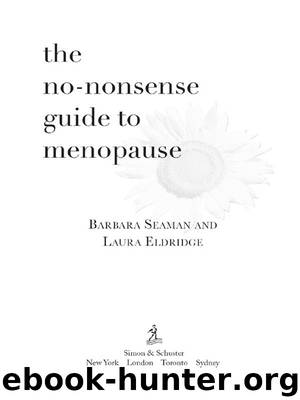The No-Nonsense Guide to Menopause by Barbara Seaman & Laura Eldridge

Author:Barbara Seaman & Laura Eldridge
Language: eng
Format: epub
Publisher: Simon and Schuster
Published: 2008-07-15T00:00:00+00:00
14
change of pace
menopause and exercise
Take exercise: for while inaction weakens the body, work strengthens it; the former brings on premature old age, the latter prolongs youth.
—A. CORNELIUS CELSUS, FIRST-CENTURY ROMAN MEDICAL WRITER
there are always so many reasons why people either don’t exercise or don’t do it enough. They’re busy, lazy, confused about what exercises to do, think joining a gym is too expensive, they’re too old…this list goes on.
You really are never too old to start: the National Institutes of Health (NIH) reports that exercise and physical activity can “improve the health of people who are 90 or older, who are frail or who have the diseases that seem to accompany aging.” 1 So you healthy meno-babes out there have no excuse. Forty? C’mon. Fifty? No problem. Sixty? Why not?
First, let’s be clear about what we mean when we say “exercise.” We mean any sort of movement that gets you using your body in a healthy and active way, from walking down the stairs of your apartment building to running a marathon, from carrying your own groceries home to becoming an expert yoga practitioner, from taking ten-minute walks to becoming a regular gym rat. You don’t have to spend hours a week at a fancy gym. You might start by doing a couple of hours of yoga and tai chi each week. Perhaps you simply commit to engaging regularly in an activity like gardening or housework that gets you moving. The point is to do something on a daily basis.
Exercise is like religion in American culture: it is spoken of in mystic terms, and we are assured daily by countless media sources that if we do enough of it or the right sort of it, we will avoid a host of terrible things, including chronic disease, obesity, and cancer. The Mayo Clinic estimates that “you can reduce your risk of dying prematurely by almost half if you exercise every day or nearly every day.” 2 Still, even the most optimistic proponents must admit limitations.
The truth is that nothing will prevent us from dying and that data on exercise suggest simply that it can delay the onset of chronic disease. Still, there are so many benefits that we find it hard to overstate how good exercise is for you. Exercise is particularly important for midlife women because of its preventive powers but also for its ability to alleviate certain menopause symptoms.
Menopause is also a great time to make changes that will help your health for the rest of your life. The National Institute on Aging explains, “When older people lose their ability to do things on their own, it doesn’t happen just because they have aged. More likely it is because they have become inactive. Older inactive adults lose ground in four areas that are important for staying healthy and independent: endurance, strength, balance and flexibility.” 3
Knowing When to Say When: How Much Exercise Is Enough?
One of the most confusing things about starting a workout regimen is accepting that no one knows how much you should be exercising to reap the many health benefits.
Download
This site does not store any files on its server. We only index and link to content provided by other sites. Please contact the content providers to delete copyright contents if any and email us, we'll remove relevant links or contents immediately.
The Ultimate Bodybuilding Cookbook by Kendall Lou Schmidt(3853)
Warrior Workouts, Volume 2 by Stewart Smith(2498)
The Right Way to Do Wrong by Harry Houdini(1874)
10% Happier by Dan Harris(1669)
The Doctors Book of Home Remedies by Prevention Magazine Editors(1474)
Steroids: History, Science, and Issues by Standora Joan E.; Bogomolnik Alex; Slugocki Malgorzata(1451)
The Monk Who Sold His Ferrari by ROBIN SHARMA(1405)
The 7 Principles of Stress by Ori Hofmekler(1345)
Complete Guide to Prescription & Nonprescription Drugs 2014 by H. Winter Griffith(1304)
Spiritual Midwifery by Ina May Gaskin(1301)
The Dangerous Case of Donald Trump by Bandy X. Lee(1301)
Joey Green's Magic Health Remedies by Joey Green(1287)
The Ins and Outs of Gay Sex by Stephen E. Goldstone(1278)
First Aid for Colleges and Universities (10th Edition) by Mistovich Joseph J. & Limmer Daniel J. & Karren Keith J. & Hafen Brent Q(1211)
Massage Anatomy by Abigail Ellsworth(1208)
Anatomy of the Moving Body by Theodore Dimon Jr(1199)
The Anatomy of Sports Injuries by Brad Walker(1173)
The Ayurveda Encyclopedia by Swami Sadashiva Tirtha(1138)
Why Do Men Fall Asleep After Sex? by Mark Leyner(1020)
